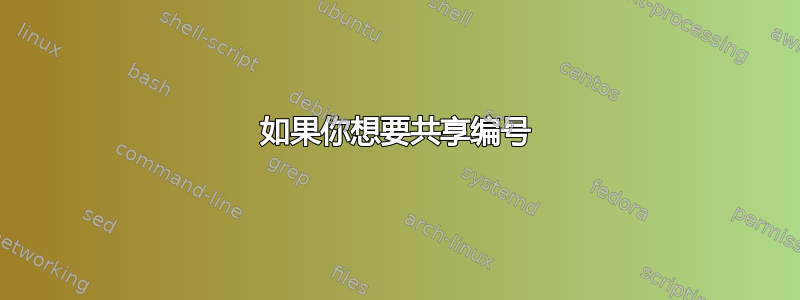
方程式通常按 (1)、(2)、(3) 等进行编号,但我还希望将某些方程式标记为 (i)、(ii)、(iii)。我希望同时使用这两种编号系统。例如:
equation (1) <-- this is the label
equation (2)
equation (i)
equation (3)
equation (ii)
equation (4)
equation (5)
ETC。
这可能吗?
答案1
这是一个简单的解决方案,它定义了一个环境,eqn可以提供roman编号。
如果你想要共享编号

% arara: pdflatex
\documentclass{article}
\usepackage{amsmath}
\newenvironment{eqn}{%
\refstepcounter{equation}\equation}
{\tag{\roman{equation}}\endequation}
\begin{document}
\begin{equation}
y=mx+b
\end{equation}
\begin{eqn}
f(x)=x^2
\end{eqn}
\begin{equation}
G(x)=\cos(x)
\end{equation}
\end{document}
如果你想要单独编号

% arara: pdflatex
\documentclass{article}
\usepackage{amsmath}
\newcounter{eqn}
\newenvironment{eqn}{%
\refstepcounter{eqn}\equation}
{\tag{\roman{eqn}}\endequation}
\begin{document}
\begin{equation}\label{eqn:linear}
y=mx+b
\end{equation}
\begin{eqn}\label{eqn:quad}
f(x)=x^2
\end{eqn}
\begin{equation}\label{eqn:trig}
G(x)=\cos(x)
\end{equation}
\begin{eqn}\label{eqn:bessel}
h(x)=J_n(x)
\end{eqn}
\begin{itemize}
\item reference: \eqref{eqn:linear}
\item reference: \eqref{eqn:quad}
\item reference: \eqref{eqn:trig}
\item reference: \eqref{eqn:bessel}
\end{itemize}
\end{document}
对于多线方程
您可以使用相同的想法,使用相同的计数器,例如命令
\newcommand{\mytag}{\refstepcounter{equation}\tag{\roman{equation}}}
如果你想要共享方程编号,并且
\newcommand{\mytag}{\refstepcounter{eqn}\tag{\roman{eqn}}}
如果您想要单独编号。
% arara: pdflatex
% !arara: indent: {overwrite: yes}
\documentclass{article}
\usepackage{amsmath}
\newcounter{eqn}
%\newcommand{\mytag}{\refstepcounter{eqn}\tag{\roman{eqn}}}
\newcommand{\mytag}{\refstepcounter{equation}\tag{\roman{equation}}}
\begin{document}
\begin{align}
y & =mx+b\label{eqn:linear} \\
f(x) & =x^2 \mytag\label{eqn:quad} \\
G(x) & =\cos(x) \label{eqn:trig} \\
h(x) & =J_n(x) \mytag\label{eqn:bessel}
\end{align}
\begin{itemize}
\item reference: \eqref{eqn:linear}
\item reference: \eqref{eqn:quad}
\item reference: \eqref{eqn:trig}
\item reference: \eqref{eqn:bessel}
\end{itemize}
\end{document}
您的问题与一篇论文中有两种方程标签
答案2
它可以通过定义一个新环境来自动实现。我们称之为romanequation:
\makeatletter
\newcounter{romanequation}
\def\incr@eqnumrom@n{\refstepcounter{romanequation}\let\incr@eqnumr\@empty}
\renewcommand{\theromanequation}{\roman{romanequation}}
\def\endmathdisplayroman#1{%
\ifmmode \else \@badmath \fi
\endmathdisplay@aroman
$$%
\global\let\df@label\@empty \global\let\df@tag\@empty
\global\tag@false \global\let\alt@tag\@empty
\global\@eqnswfalse
}
\def\endmathdisplay@aroman{%
\if@eqnsw \gdef\df@tag{\tagform@\theromanequation}\fi
\if@fleqn \@xp\endmathdisplay@fleqn
\else \ifx\df@tag\@empty \else \veqno \alt@tag \df@tag \fi
\ifx\df@label\@empty \else \@xp\ltx@label\@xp{\df@label}\fi
\fi
\ifnum\dspbrk@lvl>\m@ne
\postdisplaypenalty -\@getpen\dspbrk@lvl
\global\dspbrk@lvl\m@ne
\fi
}
\def\print@eqnumrom@n{\tagform@\theromanequation}
\newenvironment{romanequation}{%
\incr@eqnumrom@n
\mathdisplay@push
\st@rredfalse \global\@eqnswtrue
\mathdisplay{equation}%
}{%
\endmathdisplayroman{equation}%
\mathdisplay@pop
\ignorespacesafterend
}
\makeatother
以下是一个例子:
\documentclass{article}
\usepackage{amsmath}
\makeatletter
\newcounter{romanequation}
\def\incr@eqnumrom@n{\refstepcounter{romanequation}\let\incr@eqnumr\@empty}
\renewcommand{\theromanequation}{\roman{romanequation}}
\def\endmathdisplayroman#1{%
\ifmmode \else \@badmath \fi
\endmathdisplay@aroman
$$%
\global\let\df@label\@empty \global\let\df@tag\@empty
\global\tag@false \global\let\alt@tag\@empty
\global\@eqnswfalse
}
\def\endmathdisplay@aroman{%
\if@eqnsw \gdef\df@tag{\tagform@\theromanequation}\fi
\if@fleqn \@xp\endmathdisplay@fleqn
\else \ifx\df@tag\@empty \else \veqno \alt@tag \df@tag \fi
\ifx\df@label\@empty \else \@xp\ltx@label\@xp{\df@label}\fi
\fi
\ifnum\dspbrk@lvl>\m@ne
\postdisplaypenalty -\@getpen\dspbrk@lvl
\global\dspbrk@lvl\m@ne
\fi
}
\def\print@eqnumrom@n{\tagform@\theromanequation}
\newenvironment{romanequation}{%
\incr@eqnumrom@n
\mathdisplay@push
\st@rredfalse \global\@eqnswtrue
\mathdisplay{equation}%
}{%
\endmathdisplayroman{equation}%
\mathdisplay@pop
\ignorespacesafterend
}
\makeatother
\begin{document}
\begin{equation}
e^{i\pi}+1=0
\end{equation}
\begin{equation}
e^{i\pi}+1=0
\end{equation}
\begin{equation}
e^{i\pi}+1=0
\end{equation}
\begin{romanequation}
e^{i\pi}+1=0
\end{romanequation}
\begin{romanequation}
e^{i\pi}+1=0
\end{romanequation}
\begin{romanequation}
e^{i\pi}+1=0
\end{romanequation}
\begin{romanequation}
e^{i\pi}+1=0
\end{romanequation}
\begin{equation}
e^{i\pi}+1=0
\end{equation}
\begin{equation}
e^{i\pi}+1=0
\end{equation}
\begin{romanequation}
e^{i\pi}+1=0
\end{romanequation}
\begin{equation}
e^{i\pi}+1=0
\end{equation}
\end{document}
及其结果:

答案3
您可以执行以下操作:
\documentclass{article}
\usepackage{amsmath}
\begin{document}
\begin{align}
\label{a}
a+b\\
\label{b}
c+d\\
\label{c}
e+f\tag{i}\\
\label{d}
g+h\\
\label{e}
i+j\tag{ii}\\
\label{f}
k+l\\
\label{g}
m+n
\end{align}
Equation~\eqref{a}.
Equation~\eqref{b}.
Equation~\eqref{c}.
Equation~\eqref{d}.
Equation~\eqref{e}.
Equation~\eqref{f}.
Equation~\eqref{g}.
\end{document}

我可能误解了你(我不确定);你想自动编号而不必使用吗\tag?


